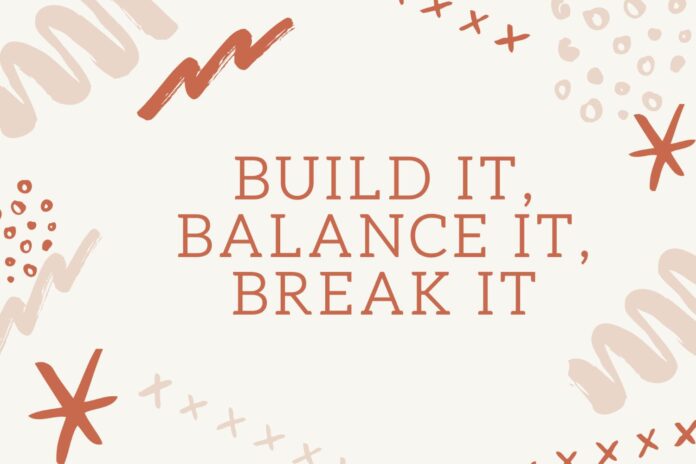In a world buzzing with screens & notifications, sometimes the boldest thing you can do is put your phone down & make something with your hands. Creativity is not limited to artists, engineers, or inventors – it’s for everyone. Whether you’re 9 or 90, there’s something powerful & deeply human about crafting, experimenting & even failing. That’s the spirit behind today’s blog: Build It, Balance It, Break It – a collection of DIY ideas that challenge your mind, spark your curiosity & maybe even inspire a few laughs when things go (delightfully) wrong.
This isn’t your average craft list. This is about pushing boundaries, making messes & learning through action. So, roll up your sleeves – let us get brave.
Why “Build It, Balance It, Break It”?
Before we dive in, let us unpack the title. These three simple steps are more than a sequence – they are a mindset.
- Build It: Begin with imagination. Use your hands & mind to create something from scratch. It could be a structure, a contraption, or even an idea.
- Balance It: Test its strength, its stability & maybe even your own patience. Find the equilibrium – physically or metaphorically.
- Break It: This part might sound destructive, but it’s not. Breaking something down helps you understand how it works. It builds resilience. Plus, it’s fun.
Together, these steps offer a hands-on philosophy that celebrates curiosity over perfection. Let’s get into some projects that embody this brave spirit.
-
The Great Spaghetti Tower Challenge
Materials: Dry spaghetti, marshmallows (or soft candy), a ruler & a timer.
Mission: Build the tallest freestanding tower using just spaghetti & marshmallows. No glue, no tape – just geometry, gravity & grit.
Balance It: See how long your tower can stay up. Time it. Nudge the table. Add a small paper flag to the top – does it still stand?
Break It: Slowly add weight or simulate a mini earthquake with a shake. What causes collapse? Can you redesign for better stability?
What You Learn: Structural design, tension, trial-and-error thinking & the joy of smashing your own creation.
-
Homemade Chain Reactions (Mini Rube Goldberg Machine)
Materials: Anything in your home! Books, dominoes, marbles, paper tubes, spoons, toy cars – you name it.
Mission: Create a complex chain reaction that ends with something simple – like popping a balloon, ringing a bell, or flipping a light switch.
Balance It: Can you make the system work smoothly from start to finish? Tweak the angles, the heights & the timing.
Break It: Deliberately pull out a step in the middle. What happens? What does it teach you about interconnected systems?
What You Learn: Cause & effect, patience, creativity & engineering in its most playful form.
-
The Cardboard Arcade Game
Materials: Cardboard, scissors, glue, rubber bands, paper clips & your imagination.
Mission: Build a working arcade game – like a mini pinball machine, a claw grabber, or a marble maze.
Balance It: Once it’s built, invite friends or family to play. Does it need tweaking? Is it too easy or too hard?
Break It: Modify a rule or remove a part to see what breaks. Then re-engineer. Maybe version 2.0 is even better!
What You Learn: Game design, problem-solving, design iteration & a huge sense of accomplishment.
-
Water Bottle Rockets
Materials: Empty 2-liter plastic bottle, water, cork, a bike pump with a needle adapter.
Mission: Build a water-propelled rocket. Fill the bottle one-third with water, cork it tightly, pump air in – & watch it fly.
Balance It: Adjust the water level. Does more water = more thrust? How does angle affect the distance?
Break It: Try different sizes or bottle shapes. What’s the highest altitude you can reach before things blow up (safely)?
What You Learn: Basic physics, propulsion & just how fun science can be.
-
DIY Bridges (Using Popsicle Sticks)
Materials: Popsicle sticks, glue, coins or weights, two flat surfaces.
Mission: Build a bridge between two chairs or books & see how much weight it can hold.
Balance It: Test with increasing weights – coins, small books, etc. What design supports the most?
Break It: Push the limit until collapse. What failed first – joints, beams, supports?
What You Learn: Engineering design, strength-to-weight ratios & how failure teaches success.
The Brave Mindset Behind Every DIY
What do all these projects have in common? They’re rooted in bravery – not just the kind that climbs mountains or speaks in front of crowds, but the kind that dares to try something unfamiliar. A brave mind is one that:
Welcomes failure as part of growth
Is curious, not cautious
Asks “What if?” instead of saying “That won’t work”
Celebrates progress, not perfection
You don’t need a degree in science or a workshop full of tools. You just need the willingness to get started.
Getting Kids & Adults Involved
These DIY ideas aren’t just for kids, although they’re fantastic for young learners. Adults, too, benefit from hands-on play. It’s a stress reliever, a brain booster & a way to rediscover the joy of creating with no rules.
Try doing these activities as a family, a team-building exercise at work, or even solo on a rainy Sunday. Set a time limit. Make it a challenge. Record your progress. Laugh at your bloopers.
Tips to Make the Most of It
- Start simple: Don’t overthink the materials or design. The magic is in doing.
- Document the journey: Take photos or videos. Even failed attempts are valuable.
- Reflect: After each project, ask: What worked? What didn’t? What can I try next?
- Stay safe: Especially when working with sharp tools, pressurized bottles, or breakables.
- Share: Inspire others by sharing your creations online with hashtags like #BuildItBalanceItBreakIt.
In the End, It is Not About Perfection
Perfection is overrated. The greatest innovations, the wildest art & the most memorable learning come from imperfect, messy & brave beginnings. You might not build the Eiffel Tower out of spaghetti, but you will build something far more important – a mindset that embraces creativity, resilience & fun.
So next time you’re bored, anxious, or just seeking a spark of inspiration, remember this mantra: Build it. Balance it. Break it. Brave minds aren’t afraid to make, test & start again.
Now go on – grab some tape, a bottle, a stick, or a spark of imagination. The world is your workshop.
Have your own DIY idea that fits the theme? Drop it in the comments or tag us on social media. Let’s build a brave community, one experiment at a time.




